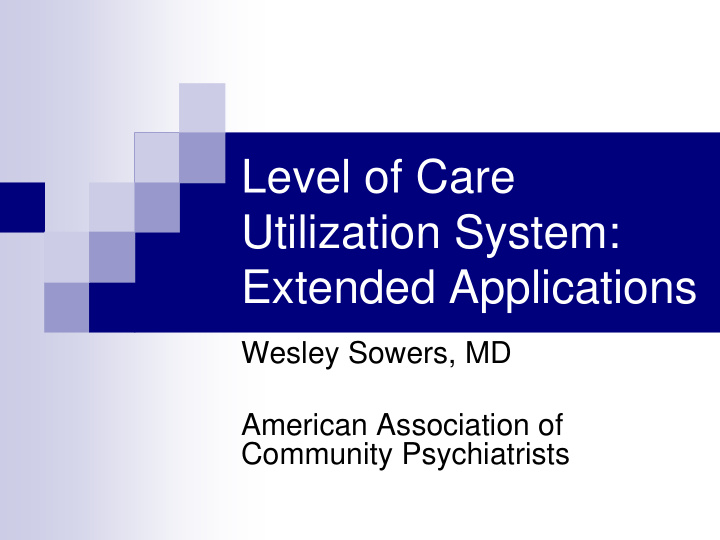



Level of Care Utilization System: Extended Applications Wesley Sowers, MD American Association of Community Psychiatrists
LOCUS Overview � Balance of Quality and Resource Use � Defines Complete Continuum of Flexible Service Arrays – Individualized Planning � Comprehensive Functional Rating System � Integrated MH and Addiction Parameters- Not Diagnostically Bound � Uncomplicated- User and Consumer Friendly
LOCUS Overview (cont.) � Quantifiable rating scales-simplified decision support � Dynamic Assessment – Eliminates Continuing Stay and Discharge Criteria � Adaptable- Universal Applicability � Reliably Applied, Valid Results � Supports Recovery Oriented Services
Clinical Efficiency � Increasing Demands for Coherent, Streamlined Clinical Systems � Integrated Elements � Eliminate Fragmentation, Redundancy, Lack of Clarity � Reduce Administrative Burden � Generation of Useful Information � LOCUS as an Organizational Tool
Elements of Clinical Systems � Assessment � Placement � Service Planning � Service Guidelines (Pathways) � Progress Documentation � Outcome Monitoring
Assessment � LOCUS Semi-Structured Interview � Traditionally Structured Interview Relationship to Rating Domains: � HPI: Dim I & II � Psych Hx: Dim III & V � Substance Hx: Dim III & V � Medical Hx: Dim III & IV � Social Hx: Dim IVA & IVB � MSE and Plan: Dim II & VI
Assessment (cont) � Alternatively, Revise Assessment to Coincide with LOCUS Dimensions � Functional Assessment: � Dim I: HPI emphasizing high risk behaviors � Dim II: HPI emphasizing alterations in ADL � Dim III: HPI - Psych, Addiction, and Med Sx � Dim IV: Social History � Dim V: Psych, Addiction, and Med Hx & Rx � Dim IV: Mental Status Exam
Assessment � Either way, LOCUS ratings are completed simultaneously with assessment � Integrated approach allows reduction in time and greater clarity in thought process � Eliminates redundancy � Potential for consumer participation in assessment process
Need and Service Matching: Systems Issues � Placement is the primary role of LOCUS � Intensity of need for treatment and support services � Consistent, Equitable, Rational � Pooled Data on Placement Recommendations � Allows analysis of utilization of system resources � Provides opportunity for quality improvements
Program/Service Planning � What is system capacity to meet needs? � What needed services are unavailable? � Where are gaps greatest and most costly? � What are the priorities for service development?
Information Available � Number of people recommended for each level of care in current assessment � Number of people assigned to each level of care in current assessment � Length of stay per level of care � Variances between raters � Separate by demographics and diagnosis
Reconceptualization of Service System � Service arrays allow tailoring to individual needs rather than vice versa � Indistinct boundaries allow for thinking of gradual transitions and collaboration between elements � Opportunity for consumer – provider collaboration in shaping the system and meeting community needs
Treatment/Service Planning � LOCUS differentiates problems in six domains � Develops problem profile unique to individual and moment in time � Establishes intensity of need for services � Identifies priorities for interventions � Establishes objectives for transitions
Treatment Planning Elements � Problem definition � Short and long term goals � Determination of immediate objectives � Interventions to achieve progress � Measurable indicators of progress
Problem Identification � Six dimensions define problem areas � Highest dimensional scores focus for intervention � Criteria selected determine problem qualifiers (specifics)
Short and Long Term Goals � Level of care determines short term goal � Transition to less restrictive/intensive level of service � Characteristics required to make transition � Long term goal related to course of illness and return to health � Recovery! � Non-specific
Problem Specific Objectives � Converse relationship to problem qualifiers � Direct relationship to short term goals � Measurable
Interventions � Concrete elements of plan to achieve progress � What will be provided? � How often? � Who will be responsible? � May provide assistance with several objectives
Indicators � Observable behaviors or expressions that can be quantified � “Suffix” of Objective – that which will be measured, counted or observed. � Indicates progress toward stated objective � May be used for objectives related to more than one level of care - phase specific
LOCUS Treatment Planning System � Dimensional ratings identify problems and priorities for transition � LOC recommendation determines short term goal � Specific criteria selections determines qualifiers � Qualifiers determine objectives menu � Objectives determine indicator menu � Interventions selected from a gen. menu
Participatory Planning � Consumer participation in criteria selection � Consumer participation in selection of interventions and indicators from menus � Develop consumer investment in and understanding of what he/she is attempting
Pathways � Structured management of “typical” case � May be programmatically or diagnostically bound- often both � Quality tool to assure that all relevant tasks are completed in a timely manner � Deviation from the pathway becomes impetus for inquiry and change
LOCUS Pathways � Pathways are level of care specific � Related to treatment plan interventions � Expectations for change and accomplishing objectives � Elements of pathway essentially the same, but frequently more flexible � Outcome driven
Progress Documentation � Problem oriented progress note � Assists in ongoing ratings and transition decisions � Focus attention on measurable behaviors � Ongoing re-evaluation of the treatment plan � Tied to pathway, identification of deviation � Provides a concise, coherent, clinical report
Outcome Monitoring � Not yet validated for outcomes….but � Well suited for outcome measurement � LOCUS scores over time represent course of illness and recovery � Sustained reduction of need indicate good outcome � Overall, gives good indication of function, engagement in change process, and social connection
Summary � LOCUS based integration of clinical systems � Results in greater coherency, efficiency, and quality of care � Improves access to information � Provides opportunities for quality improvement � Consumer engagement and involvement in recovery process
Recommend
More recommend